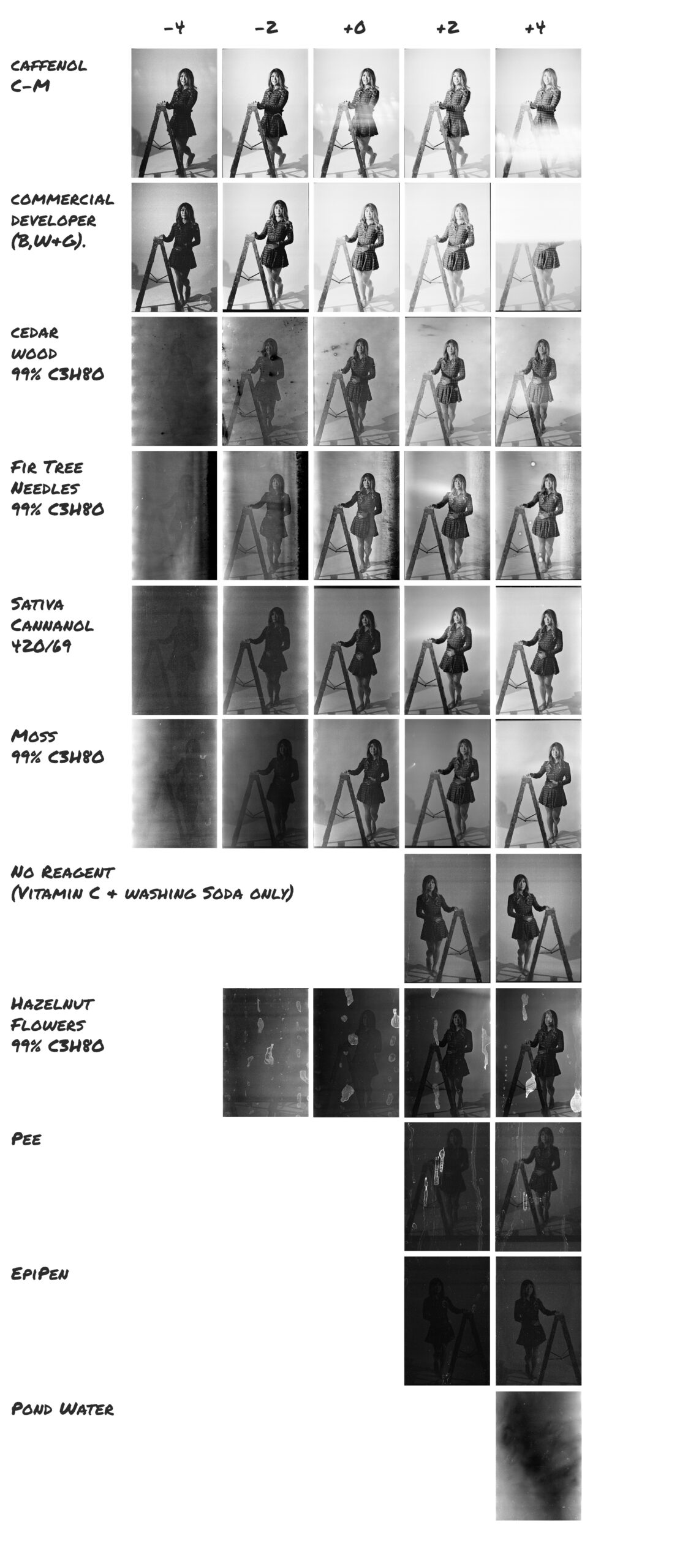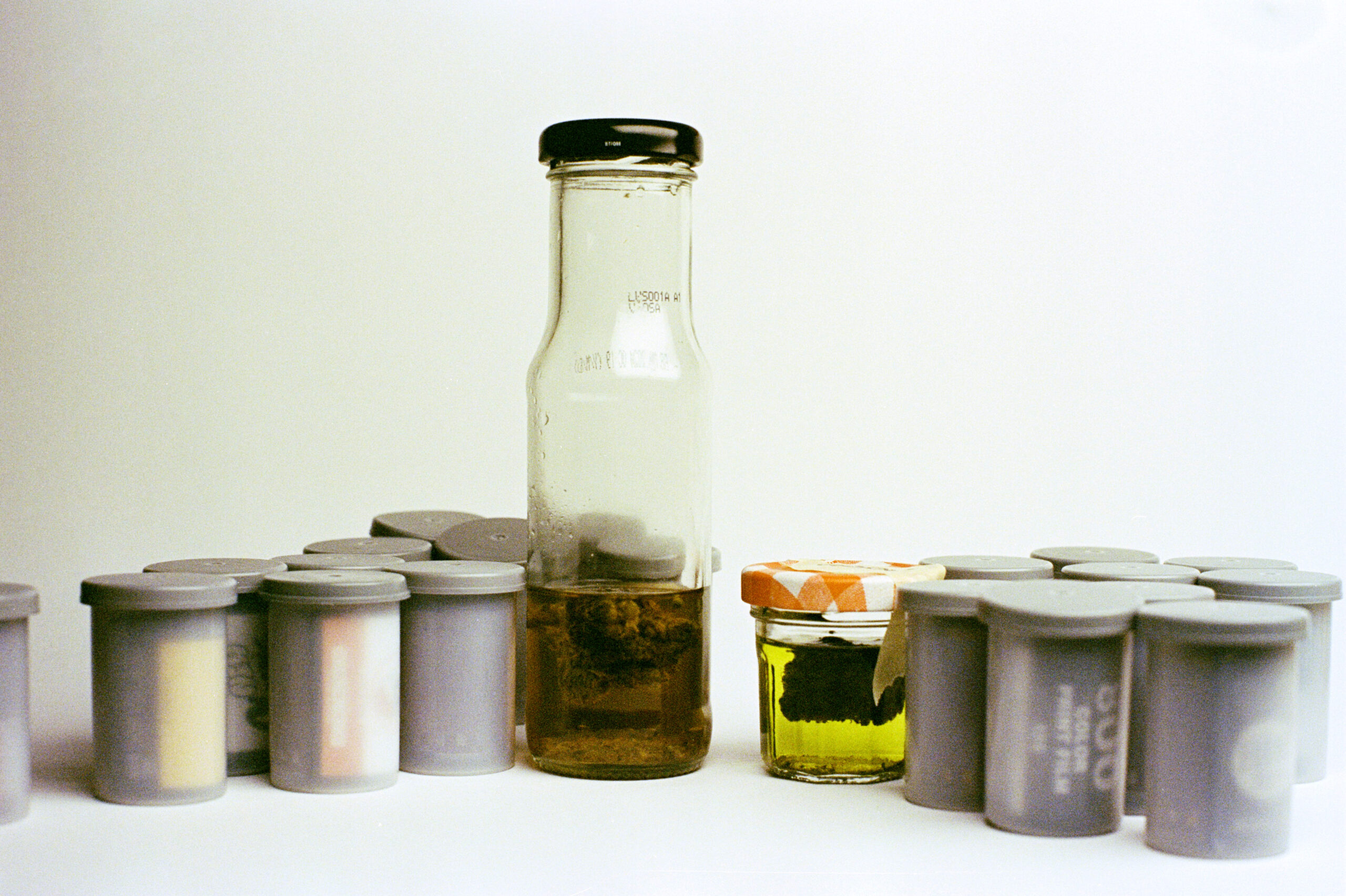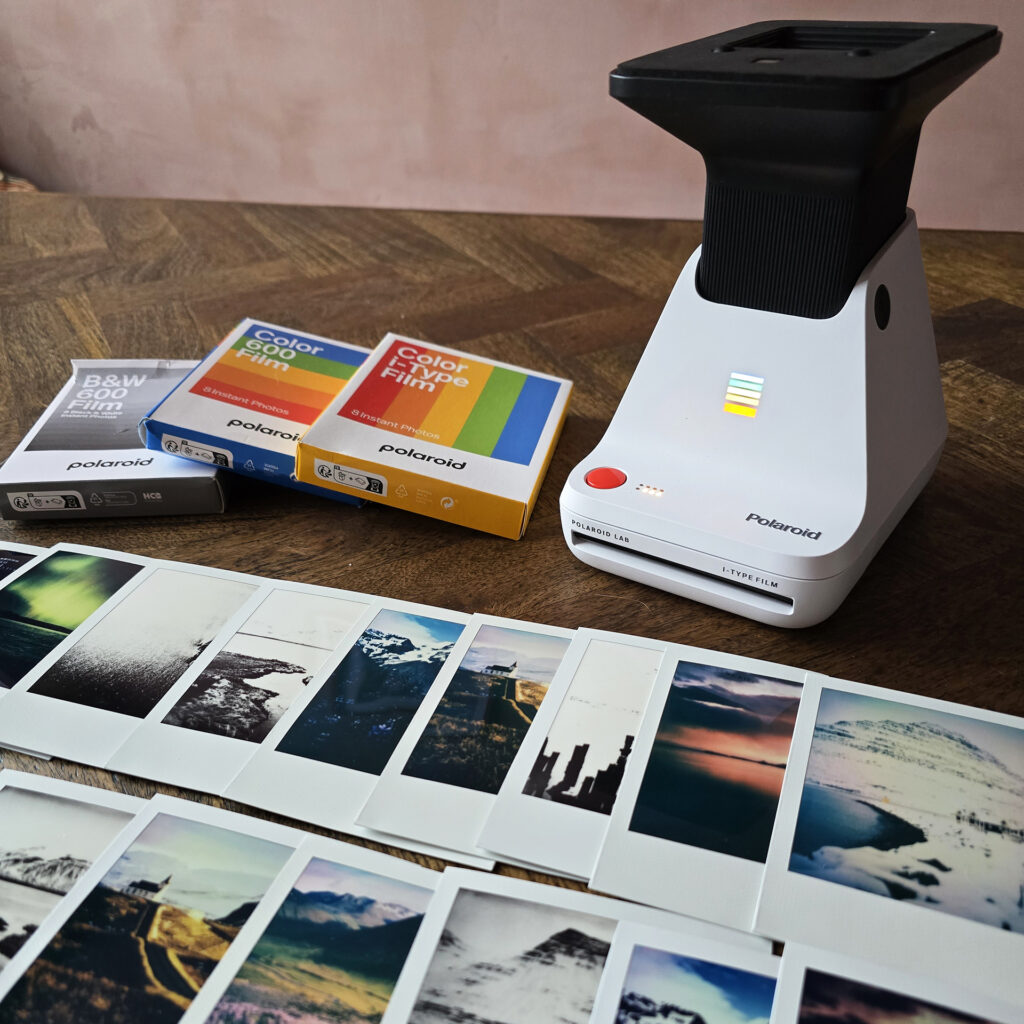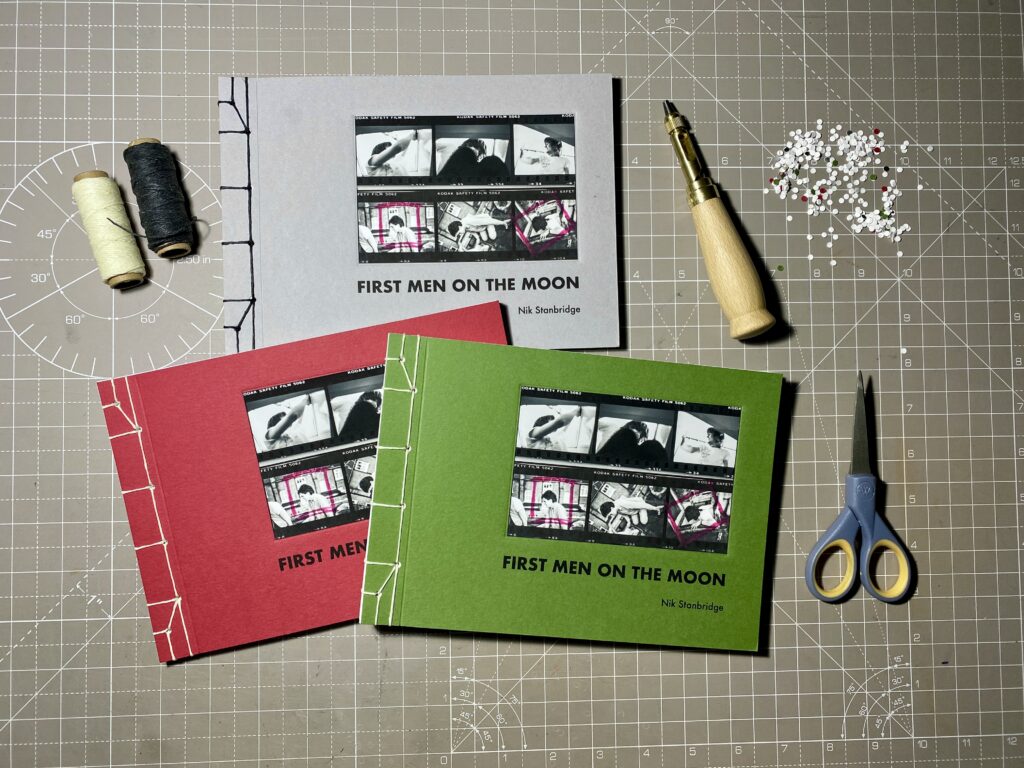Grant Haist claimed some time ago that you could develop film in almost anything, including pee. His words echoed across the internet and IRL when I shared the project details that Daren, Yvonne, and I have worked on for the past few months with my photography friends.
Theory and practice often diverge. Chemistry is a complex science; it’s even more complex in the real world, where no pure compounds exist. While a reaction may be expected, it could easily be prevented by contaminants or even accelerated by accidental catalysts.
That said, the conditions for desirable chemical reactions for film development are usually quite forgiving. Unless you switch the order of the developer baths or use expired reagents, you’ll see results. I’ve previously guestimated development times and was off the desired temperature by as much as 5℃ in either direction with little to no issues. Even the thinnest and foggiest negatives could still yield an image with a good scanner. That’s not to say that clean, even, reticulation-free images with excellent contrast and grain texture don’t take effort and diligence.
TL;DR: cannabis ✅, pig’s blood ✅, pee ❌, EpiPen ❌.
Find full results, recipes, and discussion here. Watch Daren’s video (@LearnFilmPhotography) about the project and the results here. Follow Yvonne (@YvonneHansonPhotography) for an upcoming video about the pig’s blood experiment.
Note: This project was originally Daren’s idea. It would not be possible without his and Yvonne’s help and guideance. In a previous version of this article, I failed to properly credit Daren and Yvonne, for which I’d like to apologize. Please follow their excellent journey through film and photography on YouTube (links above) as well on Daren’s website, Learn Film Photography and Yvonne’s Instagram.

The science (ish).
Phytogram explains why coffee works as a film developer quite well in the first paragraph of his “Why it works” page:
Industrial developers often contain the active ingredients metol and hydroquinone. These two chemicals are superadditive, they have a synergistic effect. Both can be classified as phenols, a group of chemicals containing one or two electron rich groups of atoms, which provide the necessary electron to initiate development. Coffee contains several phenols making it suitable as a developer, especially in combination with vitamin C which provides the superadditivity similar to industrial products. This occurrence of phenols in coffee is the basis of Caffenol developer.
Daniel Keating did an excellent job at extending and formalizing the process of measuring and identifying possible non-commercial developers here on 35mmc. His method involved looking up documented measurements of phenolic compounds in the material and comparing those to coffee to better estimate the amount of material needed. So if your material has 2x concentration of polyphenols than coffee, you’ll need to use half the coffee measurement from the Caffenol-C-H recipe.
Many organic materials have had their polyphenol content documented in scientific papers, many of which are posted for free. And so Daren, Yvonne, and I decided to take that data and put it to put old photography myths to the test and have some fun in the meantime.
We know that plants and bodily fluids can vary significantly in their chemical makeup as well as their entire composition, which could affect the reaction. So, we decided to bracket our shots widely (from -4 to +4 stops) to give all of our compounds a decent chance.

Cannabis.
In total, we made 20 bulk-rolled short rolls of HP5+ that we used to create standardized sets of our model (@lilianlihua) and the stationary object exposures. We also used five or so additional rolls of HP5+ to double-check our hypothesis.
Daren, Yvonne, and I used all that film to test a few of our pet theories and combined everything into one giant experiment.
My focus was cannabis. The prohibition on recreational use of this popular plant ended in Canada nearly four years ago, and today, April 20th or 4/20, is an international counterculture celebration of this plant’s effects on the human body and society.
Developing film in weed felt like a fitting extension of the Beernol and Winol traditions. Plus, the plant has a very high polyphenol concentration, which makes it an ideal candidate for the experiment.
My local dispensary sells the sativa strain variety for about $5-10 per gram, which should be enough to develop a roll of film, according to my calculation. This isn’t cheap — unless you happen to grow your own plants (which is also legal in Canada).
Having done all the work of getting the materials, bulk loading the film, arranging a photo shoot, and developing, we finally got to pull a roll of HP5+ developed in what I call Sativa Cannanol. And it worked!
Frankly speaking, the negatives looked thin (which isn’t necessarily a bad thing), and the tests I ran suggest that the optimal exposure index for HP5+ is just 25 — a far cry from the box ISO 400. Nevertheless, weed did much better than most of our developers. In fact, developed in Sativa Cannanol, HP5+ shows excellent resolution with tight, fine grain.

Pig’s blood, pee, and EpiPen.
Yvonne’s experiment was an entire roll of HP5+ shot at box speed — developed in pig’s blood. And it worked quite well! Even at box speed, HP5+ gave decent results with about 250ml of uncongealed blood.
If you shop around, you may find pig’s blood cheaper than weed (in terms of the total amount needed per roll). But it may not be so easy, as Yvonne discovered while making a series of awkward calls to the butchers who raised their eyebrow so high you could hear it over the phone. That’s a cultural thing, of course, and so she was able to get a tub eventually. Still, as someone who was there during the development, I’ll tell you that the process didn’t look pleasant.
Daren, who suggested this idea in the first place, was set to test a photography myth that we can develop black and white film in practically anything, with EpiPen and pee standing on the fringes of possibilities.
Myths busted. EpiPen may be the most expensive and useless homebrew developer ever attempted as the negatives showed results which appeared worse than a recipe without any reagent.
Whereas pee is, first of all, eww. But on another level, it is a disappointment not only in terms of results (of which there were none) but also in that Grant Haist’s claims were nothing but an unsupported theory that’s fun to say.
More developers, detailed scans, recipes, and further discussions.
We tried 11 homebrew recipes, which we compared to the commercial Black, White, and Green chemistry and got a large range of results over the course of this experiment. I tested eight rolls of HP5+ and then one more roll of Kosmo Foto’s Agent Shadow with various mixtures to develop the best version of the cannabis developer.
These experiments took no small amount of money and effort from everyone involved. But it’s April 20th, so in celebration of 4/20, the article with the complete account of the entire experiment, all the results, and, most importantly, the Sativa Cannanol recipe, is free and ad-free.
I should add that the complete development and preparation process for cannabis (and many other developers mentioned in the article) is a little more involved than with Caffenol. It includes a 3-day ethanoic extraction process and an additional wash bath — but neither is complicated.
Continue reading “Developing Film in Cannabis: Test Results and Recipe” on Analog.Cafe.
Share this post:









Comments
Neal Wellons on Cannabis, pig’s blood, pee, and EpiPen: can these things develop film?
Comment posted: 20/04/2024
Gary Smith on Cannabis, pig’s blood, pee, and EpiPen: can these things develop film?
Comment posted: 20/04/2024
Daniel Emerson on Cannabis, pig’s blood, pee, and EpiPen: can these things develop film?
Comment posted: 20/04/2024
Fascinating enjoyable read.
You have talked me out of going down that path. Will stick with D-76 etc and keep my coffee for it's more normal consumptive use.
Yes, conventional I know.
I do like the spirit of process, adventure and discovery here ... and I know a little more about developers.
Thanks for the post :)
Regards
Daniel
Jim Hofman on Cannabis, pig’s blood, pee, and EpiPen: can these things develop film?
Comment posted: 21/04/2024
Comment posted: 21/04/2024
Comment posted: 21/04/2024
Paul Quellin on Cannabis, pig’s blood, pee, and EpiPen: can these things develop film?
Comment posted: 21/04/2024
Comment posted: 21/04/2024
Manoel Almeida @metsalmeida on Cannabis, pig’s blood, pee, and EpiPen: can these things develop film?
Comment posted: 24/04/2024
Comment posted: 24/04/2024